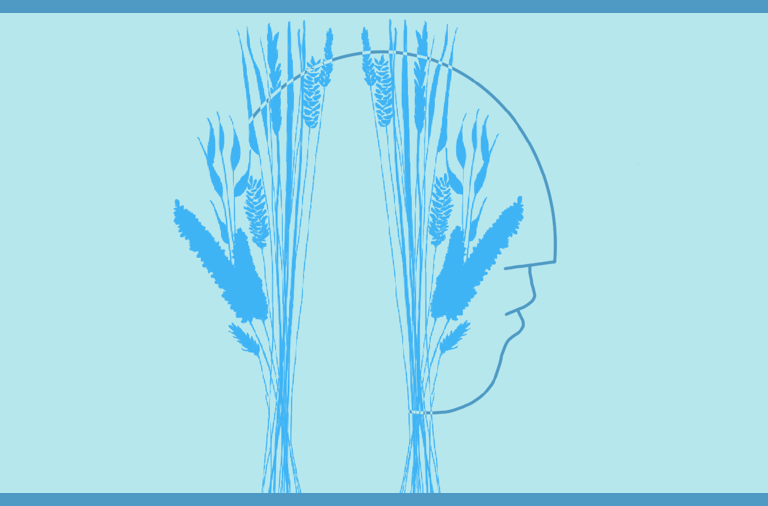The Dutch are known for scenery dominated by picturesque canals and windmills. But beneath the pretty face is deep knowledge about how to survive and succeed by being logical, creative, collaborative…and generative. Diet for a Small Planet, the book that gave birth to the global food movement, came from an era when everyone saw the picture of a tiny, beautiful, vulnerable Earth that could only survive if people worked hard to protect it. In the Netherlands, that insight and instinct has long been second nature.
THE LITTLE COUNTRY AND LITTLE FOOD MOVEMENT THAT COULD …. BY BEING GENERATIVE
“You’re not much if you’re not Dutch,” friends of mine used to tease me, whenever I showed my surprise at the outsize impact of Dutch farmers who settled in Canada. During the 1950’s, they emigrated, young and almost penniless, to many locations across North America that offered low-cost but fertile land. By the time they retired, they were case studies of how to succeed by really trying. They succeeded on their individual farms, and they succeeded as a community that knew how to pull together in co-ops and other collective efforts, including farm lobby groups and organic co-ops.
So it didn’t surprise me when The Netherlands won global attention during the fall of 2017 with a National Geographic feature that praised the exceptional productivity of its food sector. This tiny country with few obvious geographic advantages rated as the second biggest farm exporter in the world — one down from the much larger and more geographically-blessed United States.
Parallel achievements are clear in Dutch leadership of alternative and emerging food movements.
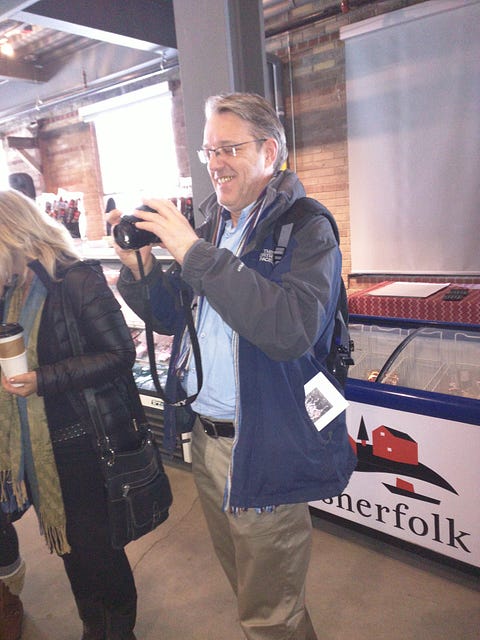 Henk Renting warms to the Brickworks farmers market, and takes a picture to capture its generative potential — our warm-up for the interview.
Henk Renting warms to the Brickworks farmers market, and takes a picture to capture its generative potential — our warm-up for the interview.
Henk Renting, who’s interviewed at length in this blog, is one example. Off the side of his desk, Henk qualifies as one of the leading food scholars of our time, having authored or co-authored some 65 oft-cited articles in prominent academic journals. The titles of this part-time writer occupy over 16 pages of Google Scholar.
Henk’s side of a tiny desk in his tiny country is provided by a tiny organization known as RUAF. The acronym stands for the RUAF Foundation, which supports Urban Agriculture and Food Security.
But I didn’t interview Henk Renting about ideas that come off the side of his RUAF desk, or even his whole RUAF desk. I wanted to learn the secrets of Henk’s role as a generative thinker.
I learned about the importance of being generative from my communications mentor, Barry Martin of Hypenotic in Toronto. Barry believes success for the food movement will flow from becoming more intentionally generative.
Generative refers to the capacity to build something awesome from something simple and modest, because it is working with the most powerful resource in the world — a spreadable idea whose time has come.
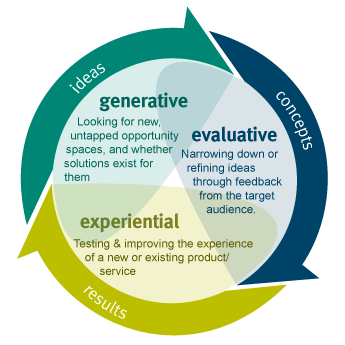 three phases of innovation: generative, evaluative and experiential
three phases of innovation: generative, evaluative and experiential
Generative Power gives the small print of a condensed footnote buried at the end of an article in an obscure journal the ability to inspire someone with the possibilities of a new way of thinking and organizing.
Like the tiny generator that powers a gigantic truck.
Barry Martin asked me to interview somebody who was generative. His suggestion generated my request for an interview with Henk, who was visiting Toronto at that very moment. To my surprise, Henk already knew what I was asking about, and already knew that generative was an idea worth making time for.
We warmed up for our interview during a tour of the farmers market at Toronto’s Evergreen Brickworks, a generative site for any who wonder whether decrepit old buildings can be restored as worldclass sites for nature exploration and farmers markets.
Then we sat down with a tape recorder over a long lunch at the Brickworks’ Café Belong — a generative site for any who wonder if authentic local foods, as prepared by down-home celebrity chef Brad Long (Belong, get it??), can name a deep human longing that inspires responses that can be replicated and adapted by grassroots groups “from below” everywhere.
I hope this introduction generates your interest in what Henk has to say about the generative force of nature behind today’s seemingly under-resourced food movement.
Act locally, think generatively!!
LUCK, PREPARATION AND OPPORTUNITY
As luck would have it, Henk was taught at university by Jan Douwe van der Ploeg, famous for championing the wisdom of food producers. He calls himself “the walking teacher,” in honor of the itinerant teachers who walked from farm to farm during the period from the 1880’s to the 1920’s, as a way to learn from farmers and spread their best practices, including farm co-ops. A generative kickstarter!!
Q: Both you and RUAF are known and trusted for your applied research. I’m guessing there’s got to be something generative about how that came to be.
A: My grandfather was a farmer, but he was very scholarly. When he had to build something, he would get a book on it. He built a violin that way. He inspired my father to be a civil engineer in the agricultural field. My dad was like a peer for me when I did research.
I studied at Wageningen, the famous agriculture research university, and graduated in 1989 with a Master of Science degree in both environmental science and rural sociology.
Applied Research felt like my calling. Right from the beginning of my studies, I wanted to make a difference for society and the environment. My heart was with social science, which gave me a way to mix my university courses with my high school interests in anarchism, Marxism and social change.
I still get satisfaction from using research for social change. That’s one reason I was hired at RUAF, where advocacy flows from research — not the other way around. That partly comes from fact that we all had a background at Wageningen.
Putting research and facts first is a Dutch tradition. We’ve always been a trading nation, so we learned to get along with people with totally different belief systems. The more decisions are based on observed facts, the better are relations with people who come from different viewpoints.
Q: How did you get started in this work?
A: When I graduated, like all young people in The Netherlands, I was called up for military service. Because I was a conscientious objector, I was given a social service assignment in the Farmers Foundation, a Non-Government Organization supporting farmers.
That’s where I learned how to do bottom-up research and to systematize information. We worked with farmers, and it gave me an ability to talk with farmers in a way we never learned at an agricultural university. It’s a great way to learn about yourself and develop the capacity to work in different environments.
It happened that this organization I did my community service for was set up by my undergraduate professor, Jan Douwe van der Ploeg, a famous expert on peasants. In 1992, shortly after I finished my community service work, we bumped into each other on the bus. He asked what I was doing, and I said I was looking for a job. And he said “come work with us.” A week later, I was working with him, without my having planned anything. I had the honor to work with him until 2005.
Q: Is there a lesson there for young people today, or are we just talking about blind luck?
A: Often, big changes come unexpectedly. You follow a hunch, and things fit. My advice is: if you are at that point, follow the hunch. I would say to students who are working in a very planned way: it often doesn’t work out that way!
Better to do networking, and look for places where you can coincide with people. Opportunities will turn up.
Q: What was it like being a university researcher?
A: Before long, I was on track for a good academic career as a permanent employee, researcher, research coordinator, and teacher, even though I only had two MSC degrees.
Professor Van der Ploeg had many connections internationally, so I got to work with leaders in the UK and Brazil. In 2002, for example, I worked with Terry Marsden of Cardiff, Wales, to write the first academic article on “short food supply chains,” which many people say anticipated the local food movement. And through the research group of Eduardo Sevilla-Guzman in Cordoba, Spain, I got in touch with the networks around agroecology, which was just starting to gain an international following.
But after ten years, I felt like I was losing my contact with practical change. I was coordinating projects, writing annual reports, writing applications for the next project. I didn’t get dirt on my hands. I was living too much within my head. I started to lose my sense of why I was doing that.
The university was imposing speed-up and budget cuts. When I started, I could work with a municipality, and do a six-month project for a modest amount of money.
Then, all of a sudden, only big projects with big budgets counted. You could not play with cheaper or more accessible ways to do research. And the researchers needed formal credentials, like PhDs, and needed to have graduate students working for them.
The other reason was more personal. I had a good but long-distance relationship with a woman in the Spanish part of the Basque country. But all the time I was living alone, and working very long hours. I felt I needed a real life. I was totally stuck. If I continue with this until I qualify for a pension, I will die, I realized.
When I made the decision to quit in 2008, I created liberty for myself — internal peace and space for change.
THE JOY OF FOOD
Q: What can we learn from your experience in the Basque country?
A: I first lived in the old city of Bilbao, my first experience in a real city with metropolitan allure. I worked as an autonomous researcher, like a consultant. Then I moved to the city of Vitoria-Gasteiz, to do research for the Zadorra Foundation on how to help young city people get established in farming, and how to bring local and organic food into school meals. (On the Zadora Foundation, which has elevated importance because of the independence movement in Catalonia, see here.)
I realized all my reasons for quitting my university job were important. I was really finding my way to new things. I was doing field projects in the community — working on school gardens, community gardens, civic food encounters, an annual meeting of farmers, researchers and city people, local fairs, seminars, tastings with locals….It was all so much fun.
The Zadorra Foundation taught me some fundamental principles. They had a brilliant rule: if you organize an event about food, you have to serve food.
This principle works in two ways. You bring in the enjoyment of food, but you also you also open up the fixed schedule of the rest of the day. The old-style presentation of a 45-minute PowerPoint lecture is not going to work around food!! People want to have a social event around food. That’s why they come! You bring in the creativity. That’s what actually attracts people!
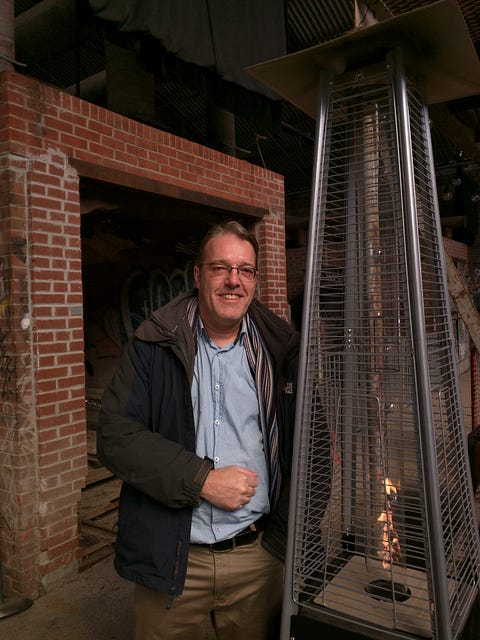 The food researcher who came in from the cold, and picked up the generative Mediterranean idea that food should be a fun experience (Actually, this picture is just Henk warming up in an outdoor section of the winter farmers market at Brickworks!)
The food researcher who came in from the cold, and picked up the generative Mediterranean idea that food should be a fun experience (Actually, this picture is just Henk warming up in an outdoor section of the winter farmers market at Brickworks!)
It’s important to work with everyday people. They want to experience things that are fun. Academic and activist work can be harsh, ambitious and frustrating, and in the end take away our energy.
But when you organize a festival, you are there with cooks and farmers, you have a great meal together, you exchange information about the meal. By the end of the day, you have this tremendous feeling of satisfaction.
The same feeling happens after gardening with school children. At the end of the day, you see their happy faces. They are delighted to walk away with a carrot.
It’s pleasant for me to see this everywhere in Toronto too. It’s about the quality of life!
The movement has to learn this. It’s the opposite of the Marxist-Leninist or Calvinist view, or even many meetings of farmer organizations, where the rule seems to be: first we must go through the suffering before we arrive at the kingdom!
THE POWER OF CONNECTIONS
Q: Anything else we could learn from the Basque country about working with the community groups?
A: That Basque NGO did lots of work on school gardens and community gardens during the early-2000s. They brought agro-ecology to the city. (On the development of these gardens, see here.) Because they shared a common language, they were able to learn about agroecology firsthand from Latin America, where it developed.
The quick spread of ideas from South America into Spain and the Basque Country is a remarkable example of the globalization of food system thinking, and of sharing among peasants.
All the ideas came together at the same time, not a bit at a time. That’s because of the power of connections.
Connections in the issues around food are essential. We are looking to reconnect the city and the countryside. We are looking to reconnect consumers with where their food comes from. And we are building and rebuilding connections between food and social life, education, public health, economy, and so on.
The NGO I worked with taught me how to be a connector. We brought people together from very different backgrounds — a girl with deep roots among political militants in town, a guy who had spent years in the agriculture ministry, a very experienced school teacher, a guy who knew virtually everybody in organic gardening, and someone from networks on agricultural research. We were about connections, and bringing worlds together that previously were not together.
That is the challenge: how do you build bridges? Because the food industry has disconnected us all. So our work becomes connecting the chef and producer who never met before. That’s why the local food movement is important in cities, and comes out of cities. It’s not just for environmental reasons. Local is where you can create connections. You can’t connect far away. Proximity is the way to connect face-to-face. That’s why the city is so prominent in local food. It’s the hub where we create connections.
CONNECTING URBAN AGRICULTURE
Q: How did urban agriculture come out of all this?
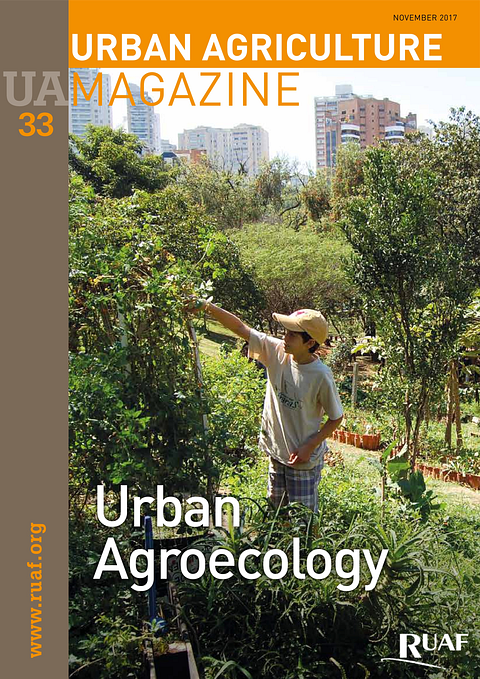 RUAF publishes Urban Agriculture magazine; the fall/2017 edition deals with urban agroecology, a name change and mindset change for urban agriculture
RUAF publishes Urban Agriculture magazine; the fall/2017 edition deals with urban agroecology, a name change and mindset change for urban agriculture
A: I probably would not have been introduced to urban agriculture if I had stayed at university in the Netherlands. As a university, Wageningen was more strongly attached to rural agriculture.
The combination of agroecology and urban agriculture didn’t exist elsewhere. That connection came about because of the generative idea of Low Input Sustainable Agriculture (LISA), because poor people in cities needed food production methods that didn’t rely on expensive fertilizers, pesticides and heavy equipment. The conditions of poor people in cities favored low-cost closed loops — building soil fertility by recycling water, food scraps and sewage that were otherwise wasted.
RUAF come out of this experience in 1999. It was spun off from an organization called ETC, which was a nursery for many other organizations, and ILEIA, which worked on agroecology, as a form of “low-external input agriculture.”
HOW TO BE A FOOD CONNECTOR?
Q: How does someone become a food movement connector?
A: First, it’s very important to listen, and to try to go beyond your sectoral or specialist interest. Unfortunately, that’s not easy. The rewards in publication and promotion are for being a specialist. This actively discourages bridge building. We have to break from the anti-connecting forces, which include academic disciplines and government departments.
Q: Is there a life lesson from you to travel while you’re still young?
A: I don’t think it’s necessary to go abroad, but to go to an experience that is unexpected, which feels interesting. Go to a place where you can do something that feels close to your heart, or go where you think you can make a change. Going outside the conventional gives you more opportunities to learn and take next steps.
Q: How did you come to leave the Basque Country and come back home?
A: Around 2003, I returned home to care for my brother, who had a terminal cancer, and to support my dad, who was now alone. While I was there, I was invited to work with RUAF.
They chose me because of my European networks and research links. RUAF had great connections throughout the Global South, but they wanted to develop support in the Global North.
Q: What can we learn from the way RUAF works?
A: RUAF’s strength is its ability to connect all kinds of spheres from all around the world. We receive funding from governments and foundations around the world. Another strength is the international network of individuals — people who feel some profound personal connection to RUAF. That shows the importance of having a regular magazine, and of investing in people and relationships.
I think our core strength is action-oriented and practice-based research. We try to make the information visible without taking a policy position, so people can make choices.
That fits with our conception of how we can change things. We can relate to and communicate with a wide range of people working around urban ag in a way that very few organizations can. We are recognized by activists, but also by people working on urban policy and international policy. We get to talk to all these people and participate in all these networks.
Q: Where do you think that approach comes from?
A: It could be Dutch. We have a history of trade. Traders have to communicate and mediate with all kinds of people. And we have a tradition of “polder politics” because we live in low-lying land (polder) that is always in danger of being flooded if the dykes don’t work. If you live with people in a polder, you have to work things out, or you’ll all drown. You need to talk with everybody. You need to get everybody on board.
For me, being a researcher and an activist is the same thing. RUAF does research that plays a role in conceptual development — how we define and systemize things, and identify their functions. This is essential for designing strategies.
You can only develop good policies if you are clear about what urban ag is, and what its social and economic functions are. We have a hands-on definition of theoretical concepts. We break them down and see if they might open up new policy. That’s how we link knowledge and social change.
RECONNECTING WITH OURSELVES
Q: Well, that begs the question: what is urban agriculture?
A: There are many agendas that can be linked to urban agriculture.
One is a human agenda. I used to tend my own big gardens in my undergraduate days, and when I was in the Basque country. I think it’s about a lot more than a practical and low-cost way to get food to eat.
Growing food is the most basic, primordial way humans connect to nature. We work with soil, seeds and plants in co-production with Nature. Food is not just any old product. It becomes part of our body, so we become one — as in you are what you eat, in a very ontological sense. That’s why food and gardening are so often linked to spirituality, and seen as so essential to the meaning of life.
For me, urban ag is about connection to the land. The city is about a built environment that is separate from Nature, and urban agriculture is a way to bring the rural connection with nature into the urban built environment, and rediscover that part of ourselves.
I don’t see urban agriculture as solving the production problem of feeding the world. Urban ag is more about social, cultural and educational relationships than production. It’s about consumers wanting to be engaged.
Urban ag can also be seen as part of the localization movement to overcome the huge distances that food travels to get to the city. We need to reorganize food more territorially, so food can be grown closer to the city — including in the city.
A NEW SECTOR
Urban ag is part of building the three pillars and partnerships of a new food system — the private sector, the government, and civil society sectors. When I lived in the Basque country, I could see that government was no longer at the center of innovation in shaping the future of industry and society. Government saw its jobs as creating the market conditions for business to thrive in, and that’s it..
Urban ag is one of the important spheres where civil society is taking control of food as a social issue. Gastronomy is another part. People are rediscovering food, and want to be skilled and reskilled and competent. It’s a matter of social control, social structures, and the control over daily life.
If you look at places where there is a successful food movement, it is where there is organization of the three pillars — government, the private sector and civil society. There are food policy councils and citizen assemblies. You can see that in the last round of municipal elections in Spain, where new leaders with a municipalist agenda were elected in Madrid and Barcelona.
WHY IS THE MILAN PACT A GAME CHANGER?
Q: I think this theme relates to the Milan Urban Food Policy Pact of 2015, which has sections dealing with all-encompassing action frameworks. How did you get involved in one stage, and how can all of us get involved now?
A: RUAF had quite a bit of input into the action framework section of the Milan pact. People in the city contacted us because someone with the Mayor’s office had done a study session with us years before. We also worked well with Thomas Forster from the US, who coordinated technical matters on the pact.
I think the Milan Urban Food Policy Pact is a “game-changer.” The fact that we now have this pact has changed reality. It gives city governments and social movements a roadmap, and also permission to start on the journey.
The Pact was presented as one of the highpoints of the Word Expo held in Milan. The release was attended by senior United Nations officials, including the head of the FAO and the secretary-general of the U.N. This is the first time such real recognition has been give to the leading role of cities in sustainable food systems.
The Pact is open broad enough to be truly generative — here is a general statement about principles of food security, food governance and a 37-point action agenda; and it basically says to whoever is inspired by it “do with it what you want.”
It is the first high-ranking document that gives an integrating and far-reaching framework for urban programs and policies. Cities that have felt they were limited to work on food and economic development now have a credible basis for justifying food work because it creates jobs, localizes the economy, and promotes sustainability, resilience, and very importantly, social inclusion and equity.
Policy-wise, it is strong on access to land, which is critical, and very strong on social inclusion — two issues that many governments have side-stepped in the past, preferring to support action around the climate but not around social justice. It is not just made up of generalities. The framework for action has 37 very concrete points.
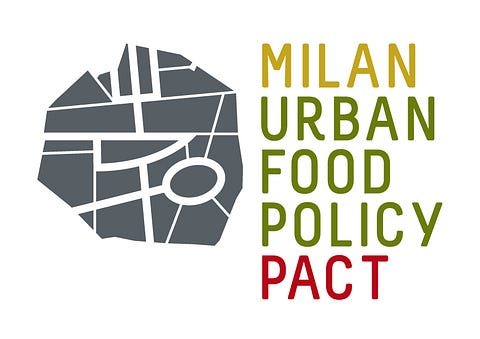 If the Milan Pact is only for mayors, it will not work, Henk Renting warns
If the Milan Pact is only for mayors, it will not work, Henk Renting warns
My concern is that, as of now, it is a statement of mayors. It should not stay only as a text of government. If it is only for mayors, it is not going to work. It needs to go much broader.
It should be a text for all urban people — especially the private sector and civil society. The danger is that it could become another formal statement, and nothing really happens on the ground. There is no excuse for that in the Pact. The Pact’s is very clear that all departments of cities need to work together on food issues, and very clear on the equal importance of government, the private sector and civil society. This is very important recognition for all three pillars.
What’s really important is find some way to connect with what’s happening on the ground. I’d like to see exchanges of cities in a certain region meeting to learn from each other, or cities emphasizing specific themes meeting to learn from each other.
It’s now generative. It’s creating its own reality. People can show the document and say, “Look! We should do something!”
Q: Maybe the world’s 300+ food policy councils could endorse it, and bring civil society groups on board?
A: That would be great!!
(f you want to be sure you get other items I write, please sign for my free newsletter on food & cities at http://bit.ly/OpportunCity)


